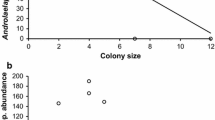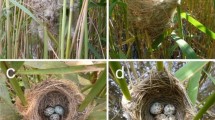Abstract
The hypothesis that cooperative breeding entails a cost in terms of transmission of ectoparasites was tested by a comparative analysis among sympatric Australian passerines. The general trend found using the allometry method and outgroup analysis indicates that contagious ectoparasites are not more common on cooperatively breeding than on non-cooperatively breeding hosts. Body weight, migratory patterns and relative abundance of hosts are factors far more important than cooperative breeding that affect the levels of ectoparasitism in the host genera studies. Ectoparasitism increases with host body weight and relative adundance, while sedentary host genera tended to show less hippoboscid fly diversity than migratory host genera. There is an interaction between breeding system and migratory pattern when relative density of contagious ectoparasites (i.e. mites, ticks and bird lice) is considered: the number of contagious ectoparasites per host is larger on cooperatively breeding host genera than on non-cooperatively breeding host genera among sedentary passerines, but the trend is reversed for migrant passerines.
Similar content being viewed by others
References
Alexander RD (1974) The evolution of social behaviour.Annu Rev Ecol Syst 5:325–383
Anderson JF, Magnarelli LA (1984) Avian and Mammalian hosts for spirochete-infected ticks and insects in a lymc disease focus in Connecticut. Yale J Biol Med 57:627–641
Arendt WJ (1985) Philornis ectoparasitism of Pearly-eyed Thrashers II. Effects on adults and reproduction. Auk 102: 281–292
Arlian LG, Vyszenski-Moher DL (1987) Nutritional ecology of parasitic mites and ticks. In: Slansky F, Rodríguez JG (eds) Nutritional ecology of insects, mites, spiders and related invertebrates. Wiley, New York, pp 765–790
Barclay RM (1988) Variation in the costs, benefits, and frequency of nest reuse by Barn Swallows (Hirundo rustica). Auk 105:53–60
Baron RW, Weintraub J (1987), Immunological responses to parasitic arthropods. Parasitol Today 3:77–82
Blakers M, Davies SJJF, Reilly PN (1984) The atlas of Australian birds. Melbourne University Press, Melbourne
Bliss CI, Fisher RA (1953) Fitting the negative binomial distribution to biological data. Biometrics 9:176–200
Borgia G, Collins K (1989) Female choice for parasite-free male Satin Bowerbirds and the evolution of bright male plumage. Behav Ecol Sociobiol 25:445–454
Brooke MdeL (1985) The effect of allopreening on tick burdens of molting eudypid penguins. Auk 102:893–895
Brown JL (1987) Helping and communal breeding in birds. Ecology and evolution. Princeton University Press, Princeton
Bucher EH (1988) Do birds use biological control against nest parasites? Parasitol Today 4:1–3
Büttiker W (1969) Parasiten und nidicolen der Uferschwalbe. Mitt Schweiz Entomol Ges 42:205–220
Christidis L, Schodde R (1991) Relationships of Australo-Papuan song birds-protein evidence. Ibis 133:277–285
Clark L, Mason JR (1985) Use of nest material as insecticidal and anti-pathogenic agents by the European Starling. Oecologia 67:169–176
Clark L, Mason JR (1988) Effect of biologically active plants used as nest material and the derived benefit to starling nestlings. Oecologia 77:174–180
Clarke MF, Heathcote CF (1988) Methods for sexing and ageing the Bell Miner Manorina melanophys. Emu 88:118–121
Coddington JA (1988) Cladistic tests of adaptational hypotheses. Cladistics 4:3–22
Conover WJ (1980) Practical nonparametric statistics, 2nd edn. Wiley, New York
Davies CR, Dye CM (1991) Malaria infection rate of Amazonian monkeys increases with sleeping group size. Bull Br Ecol Soc 22:39–44
Davies CR, Ayres JM, Dye C, Deane LM (1991) Malaria infection rate of Amazonian primates increases with body weight and group size. Funct Ecol 5:655–662
Davies NB (1985) Cooperation and conflict among dunnocks, Prunella modularis in a variable mating system. Anim Behav 33:628–648
Duffy DC (1983) The ecology of tick-parasitism on densely nesting peruvian seabirds. Ecology 64:110–119
Emlen JT (1986) Responses of breeding Cliff Swallows to nidicolous parasite infestations. Condor 88:110–111
Emlen ST, Wrege PH (1986) Forced copulations and intra-specific parasitism: two costs of social living in the White-fronted Beeeater. Ethology 71:2–29
Emlen ST, Wrege PH (1989) A test of alternate hypotheses for helping behavior in White-fronted Bee-eaters of Kenya. Behav Ecol Sociobiol 25:303–319
Fowler JA, Cohen S (1983) A method for quantitative collection of ectoparasites from birds. Ring Mig 4:185–189
Fowler JA, Williams LR (1985) Population dynamics of Mallophaga and Acari on Reed Buntings occupying a communal winter roost. Ecol Entomol 10:377–383
Freeland WJ (1976) Pathogens and the evolution of primate sociality. Biotropica 8:12–24
Freeland WJ (1977) Blood-sucking flies and primate polyspecific associations. Nature 269:801–802
Gaston AJ (1978) The evolution of group territorial behaviour and cooperative breeding. Am Nat 112:1091–1100
Gehlbach FR, Baldridge RS (1987) Live blind snakes (Leptotyphlops dulcis) in eastern screech owl (Otus asio) nests: a novel commensalism. Oecologia 71:560–563
Godfrey RDJr, Fedynich AM, Pence DB (1987) Quantification of hematozoa in blood smears. J Wildl Dis 23:558–565
Gregory RD, Keymer AE, Harvey PH (1991) Life-history, ecology and parasite community structure in Soviet birds. Biol J Linn Soc 43:249–262
Hamilton WD (1987) Kinship, recognition, disease, and intelligence: constraints of social evolution. In: Itô Y, Brown JL, Kikkawa J (eds) Animal societies: theories and facts. Japan Sci Soc Press, Tokyo, pp 81–102
Hamilton WD, Zuk M (1982) Heritable true fitness and bright birds: a role for parasites? Science 218:384–387
Harvey PH, Mace GM (1982) Comparisons between taxa and adaptive trends: problems of methodology. In: King's College Sociobiology Group (ed) Current problems in sociobiology. Cambridge University Press, Cambridge, pp 343–361
Harvey PH, Pagel MD (1991) The comparative method in evolutionary biology. Oxford University Press. Oxford
Hastwell K (1991) Use: of mud during preening by currawongs Strepera spp. Aust Bird Watch 14:73
Heinsohn RG, Cockburn A, Mulder RA (1990) Avian cooperative breeding: old hypotheses and new directions. Trends Ecol Evol 5:403–407
Hemmings AD (1989) Communally breeding skuas: breeding success of pairs, trios and groups of Catharacta lonnbergi on the Chatham Islands, New Zealand. J Zool London 218:393–405
Hoogland JL (1979) Aggression, ectoparasitism, and other possible costs of prairie dog (Sciuridae, Cynomys spp.) coloniality. Behaviour 69:1–35
Hoogland JL (1981) Nepotism and cooperative breeding in the Black-tailed Prairie Dog (Sciuridae: Cynomys ludovicianus). In: Alexander RD, Tinkle DW (eds) Natural selection and social behaviour. Recent research and new theory. Chiron Press, New York, pp 283–310
Hoogland JL, Sherman PW (1976) Advantages and disadvantages of Bank Swallow (Riparia riparia) coloniality. Ecol Monogr 46:33–58
Humason GL (1967) Animal tissue techniques, 2nd edn. Freeman, San Francisco
Kaspari M, O'Leary H (1988) Nonparental attendants in a Northtemperate migrant. Auk 105:792–793
Koenig WD, Mumme RL (1990) Levels of analysis and the functional significance of helping behavior. In: Bekoff M, Jamieson D (eds) Interpretation and explanation in the study of animal behaviour. Vol II. Explanation, evolution, and adaptation. Westview Press, Boulder, pp 268–303
Kuris AM, Blaustein AR, Alió JJ (1980) Hosts as islands. Am Nat 116:570–586
Ligon DJ, Stacey PB (1989) On the significance of helping behavior in birds. Auk 106:700–705
Margolis L, Esch GW, Holmes JC, Kuris AM, Schad GA (1982) The use of ecological terms in parasitology (report of an ad hoc committee of the American Society of Parasitologists). J Parastiol 68:131–133
Marshall AG (1987) Nutritional ecology of ectoparasitic insects. In: Slansky FJr, Rodríguez JG (eds) Nutritional ecology of insects, mites, spiders and related invertebrates. Wiley, New York, pp 721–739
Maynard-Smith J (1964) Group selection and kin selection. Nature 201:1145–1147
Møller AP (1987) Advantages and disadvantages of coloniatily in the Swallow, Hirundo rustica. Anim Behav 35:819–832
Møller AP (1990) Effects of parasitism by a haematophagous mite on reproduction in the Barn Swallow. Ecology 71:2345–2357
Møller AP (1991a) Ectoparasite loads affect optimal clutch size in swallows. Funct Ecol 5:351–359
Møller AP (1991b) The preening activity of swallows, Hirundo rustica in relation to experimentally manipulated loads of haematophagous mites. Anim Behav 42:251–260
Moore J, Simberloff D, Freehling M (1988) Relationships between Bobwhite Quail social-group size and intestinal helminth parasitism. Am Nat 131:22–32
Oppenheimer JR (1968) Behaviour and ecology of the white-faced monkey Cebus capuchinus, on Barro Colorado island, C.Z. PhD Thesis, University of Illinois, Urbana
Pagel MD, Harvey PH (1988) Recent developments in the analysis of comparative data. Q Rev Biol 63:413–440
Poiani A (1990) Communal roosting of the Bell Miner Manorina melanophrys, Meliphagidae. Victoria Nat 107:105–106
Poiani A (1992) Hormonal, behavioural and ecological aspects of cooperative breeding in the Bell Miner (Manorina melanophrys, Meliphagidae). PhD Thesis, Department of Zoology, La Trobe University. Melbourne, Australia
Poiani A, Rogers A, Rogers K, Rogers D (1990) Asymmetrical competition between the Bell Miner (Manorina melanophrys, Meliphagidae) and other honeyeaters: evidence from Southeastern Victoria, Australia. Oecologia 85: 250–256
Poulin R (1991a) Group-living and infestation by ectoparasites in passerines. Condor 93:418–423
Poulin R (1991b) Group-living and richness of the parasite fauna in Canadian freshwater fishes. Oecologia 86:390–394
Powlesland RG (1977) Effects of the haematophagous mite Ornithonyssus bursa on nestling starlings in New Zealand. N Z J Zool 4:85–94
Ranta E (1992) Gregariousness versus solitude: another look at parasite faunal richness in Canadian freshwater fishes. Oecologia 89:150–152
Reyer H-U, Dittami JP, Hall MR (1986) Avian helpers at the nest: are they psychologically castrated? Ethology 71:216–228
Ridley M (1983) The explanation of organic diversity. Clarendon Press, Oxford
Ridley M (1989) Why not to use species in comparative tests. J Theor Biol 136:361–364
Rogers K, Rogers A, Rogers D (1986) Bander's aid: a guide to ageing and sexing bush birds. A. Rogers, St. Andrews
Rubenstein DI, Hohmann ME (1989) Parasites and social behavior of island feral horses. Oikos 55:312–320
Russell EM (1989) Co-operative breeding—a Gondwanan perspective. Emu 89:61–62
Shearer PR (1973) Missing data in quantitative designs. J Stat Soc Ser C Appl Stat 22:135–140
Sherman PW, Seeley TD, Reeve HK (1988) Parasites, pathogens, and polyandry in social hymenoptera. Am Nat 131:602–610
Shields WM, Crook JR (1987) Barn Swallow coloniality: a net cost for group breeding in the Adirondacks? Ecology 68:1373–1386
Shykoff JA, Schmid-Hempel P (1991) Genetic relatedness and eusociality: parasite-mediated selection on the genetic composition of groups. Behav Ecol Sociobiol 28:371–376
Sibley CG, Ahlquist JE (1985) The phylogeny and classification of the Australo-papuan passerine birds. Emu 85: 1–14
Simmons KEL (1966) Anting and the problem of self-stimulation. J Zool 149:145–162
Skutch AF (1961) Helpers among birds. Condor 63:198–226
Smith RJ (1984) Determination of relative size: the “criterion of subtraction” problem in allometry. J Theor Biol 108:131–142
Sokal RR, Rohlf FJ (1981) Biometry. 2nd edn. Freeman New York
Trail PW, Strahl SD, Brown JL (1981) Intanticide in relation to individual and flock histories in a communally breeding bird, the Mexican Jay (Aphelocoma ultramarina). Am Nat 118:72–82
Vehrencamp SL (1979) The roles of individual, kin and group selection in the evolution of sociality. In: Marler P, Vandenbergh JG (eds) Handbook of behavioral neurobiology. Vol. 3 Social behavior and communication. Plenum Press, New York, pp 351–394
Wallace BM, Pence DB (1986) Population dynamics of the helminth community from migrating Blue-winged Teal: loss of helminyhs without replacement on the wintering grounds. Can J Zool 64:1765–1773
Wheeler TA, Threlfall W (1986) Observations on the ectoparasites of some Newfoundland passerines (Aves: Passeriformes). Can J Zool 64:630–636
Wikel SK (1982) Immune responses to arthropods and their products. Annu Rev Entomol 27:21–48
Wimberger PH (1984) The use of green plant material in bird nests to avoid ectoparasites. Auk 101:615–618
Yamagishi S, Fujioka M (1986) Heavy brood parasitism by the Common Cuckoo Cuculus canorus on the Azure-winged Magpie Cyanopica cyana. Tori 34:91–96
Zahavi A (1974) Co-operative breeding in Eurasian birds. In: Frith HJ, Calaby JH (eds) Proceedings of the 16th International Ornithological Congress. Australian Academy of Science, Canberra, pp 685–693
Zar JH (1984) Biostatistical analysis, 2nd edn. Prentice Hall, New Jersey
Author information
Authors and Affiliations
Rights and permissions
About this article
Cite this article
Poiani, A. Ectoparasitism as a possible cost of social life: a comparative analysis using Australian passerines (Passeriformes). Oecologia 92, 429–441 (1992). https://doi.org/10.1007/BF00317470
Received:
Accepted:
Issue Date:
DOI: https://doi.org/10.1007/BF00317470




